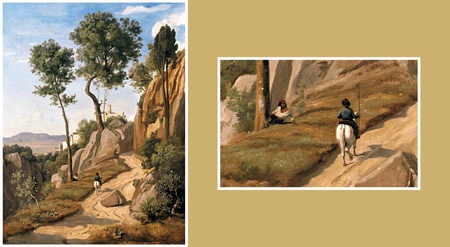Work of the Week #3
Reviewing the Salon of 1866, Émile Zola summarized the reigning concerns of French aesthetics by observing that “the work of art is a corner of creation seen through a temperament (. . . un oeuvre d’art est un coin de la création vu á travers un tempérament).” Zola’s poetic formulation became a refrain for anyone seeking to explain how Impressionism, Post-Impressionism, and other vanguard styles that privileged subjectivity, flourished during the last quarter of the 19th century. Indeed, the uniformity of Jean-Baptiste-Camille Corot’s later landscape representations, with their soft-focus approach to forms and generally muted atmospherics, was well covered by labels like “temperament” being applied to his plein-air practice.
At the Timken, we are familiar with a different Corot. View of Volterra (1838) is an appealingly crisp landscape that traces its origins back to the painter’s second trip to Italy, begun in the summer of 1834. Corot’s subject, the ancient, walled town of Volterra, occupies the near center of this large, vertical composition. In contrast to the artist’s subsequent, often more modestly-scaled pictures, View of Volterra is a sun-drenched evocation of the rugged conditions that he encountered while traversing the Tuscan countryside. As Fronia Wissman points out in 1988 in her exhibition that contextualized the Timken painting so well, Corot produced numerous sketches of Volterra and its surrounding environment. These open-air drawings and oil studies became the basis for works he would then finish in Paris. More than just enlarging these studies, Corot fundamentally reimagined the landscapes he sourced in Italy. For example, architectural landmarks that might have helped some viewers identify the site depicted in View of Volterra were left out. Our painting is less a public statement about Volterra—a portrait of the place—than it is a composite: a feeling about Tuscany, rooted in close observation and distanced by time.
As in many of his works, Corot couldn’t help but add a couple of figures to View of Volterra. More than just providing a sense of scale, the rider on horseback viewed from behind comes, more or less directly, out of his sketchbooks. A nearly identical rider appears in a smaller, contemporaneous painting by Corot, now at the National Gallery of Art, called View near Volterra. The reclining man at the base of the tree is of less certain origin. You can spot his kind, however, in similar works from the period, like Monte Pincio, Rome (The Art Institute of Chicago). Both of these figures are part of Corot’s effort to humanize an otherwise stark scene. Take these two characters out of the picture (you can accomplish this by placing your thumb on the screen, but don’t forget to wash your hands after!) and what’s left? A rutted path snaking through the trees and craggy rocks toward the fortifications in the distance. Without the fictional exchange between the two travelers in the foreground, the visual impact of the picture would be different. At the very least, they strategically acknowledge one another and, by extension, the artist invites us to join in his memory of the Italian landscape.
